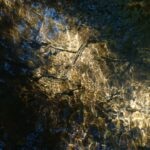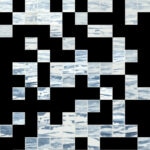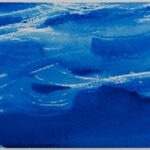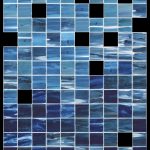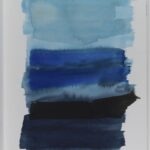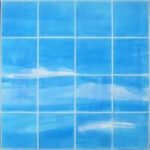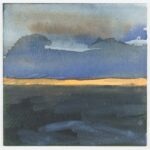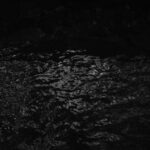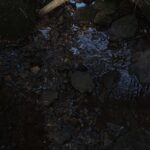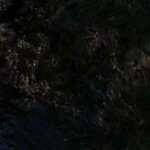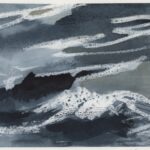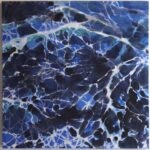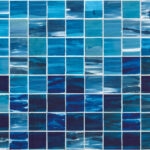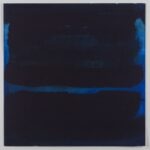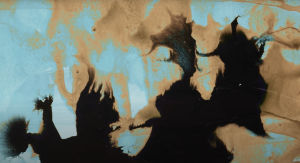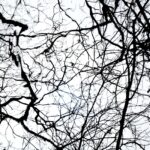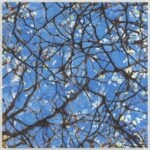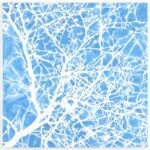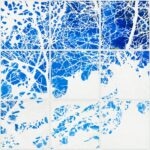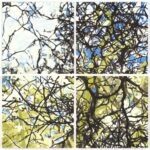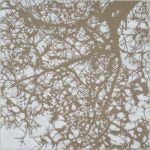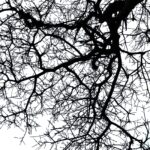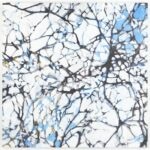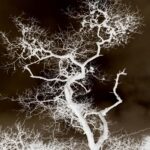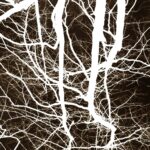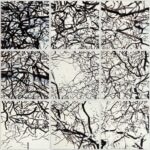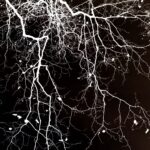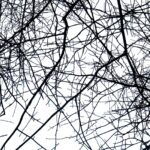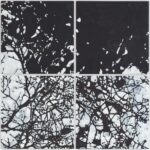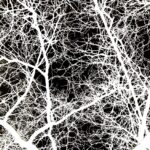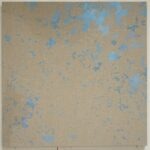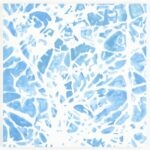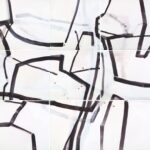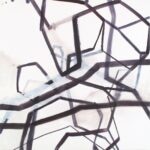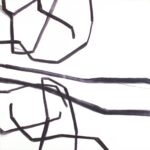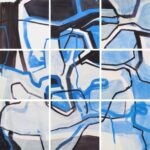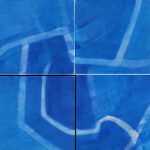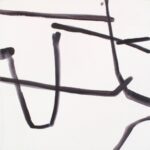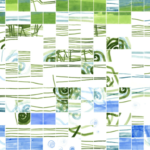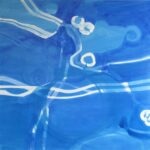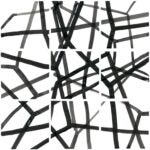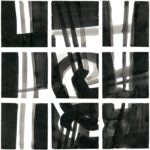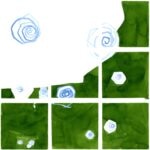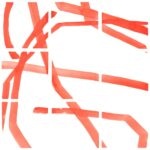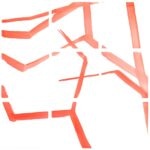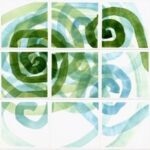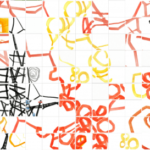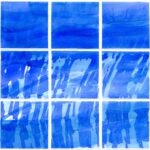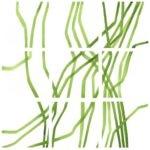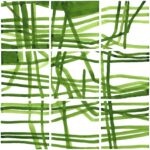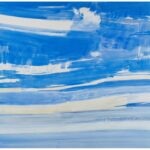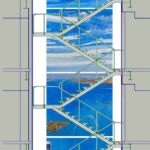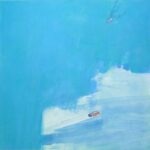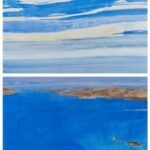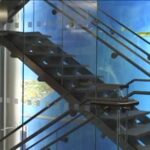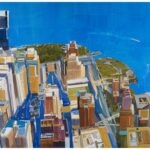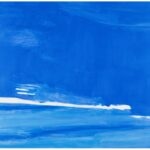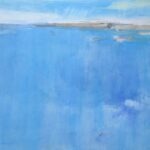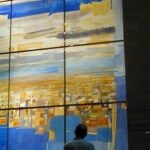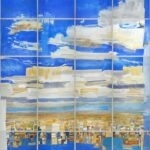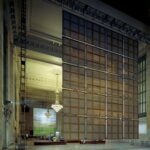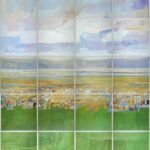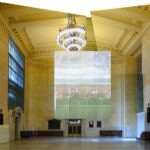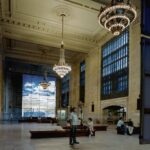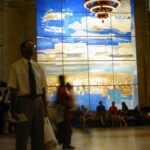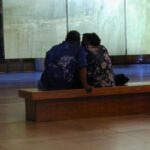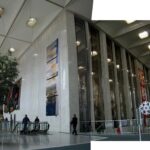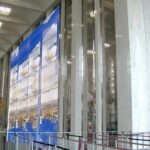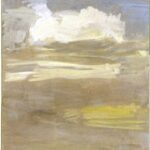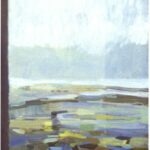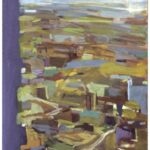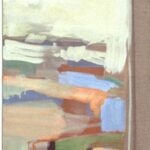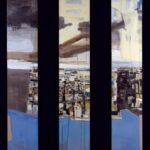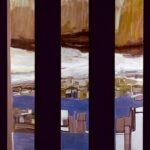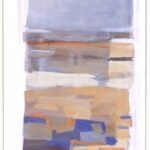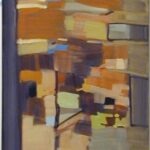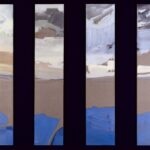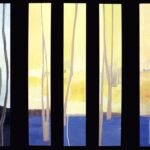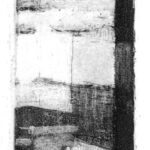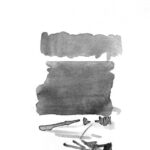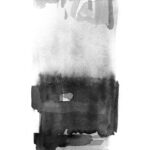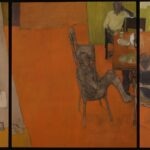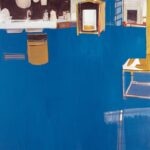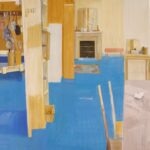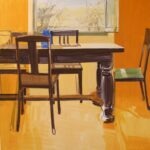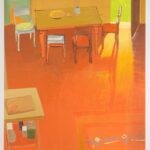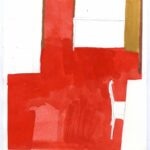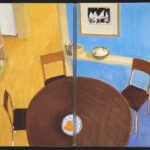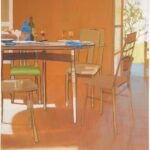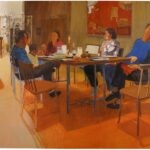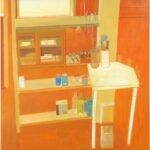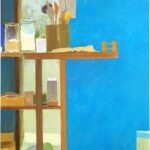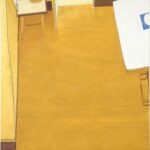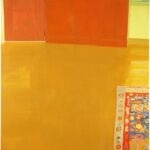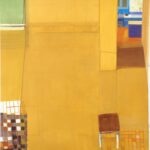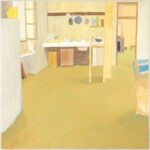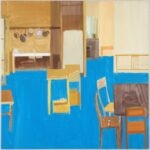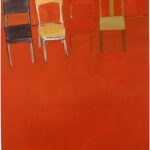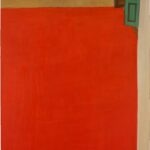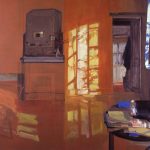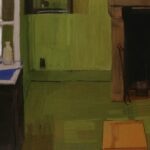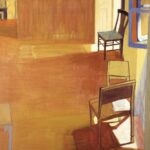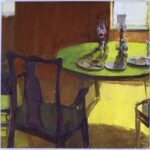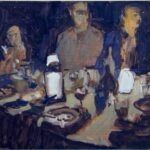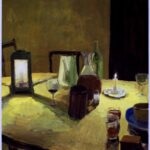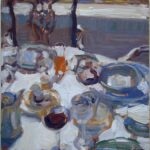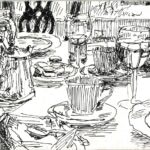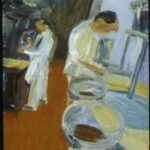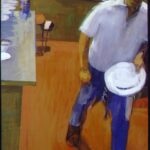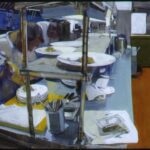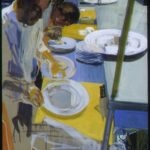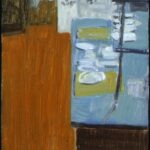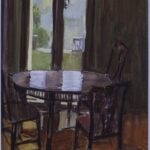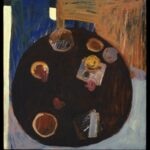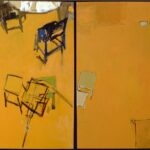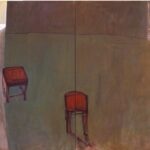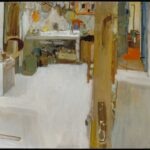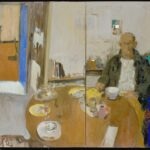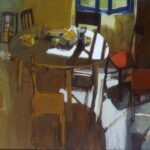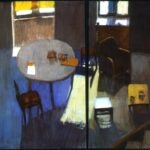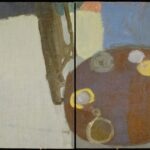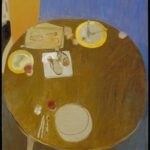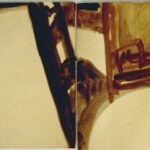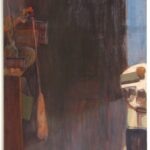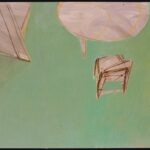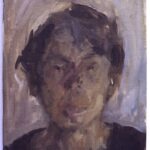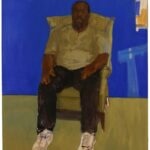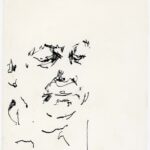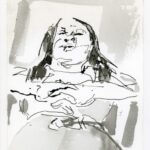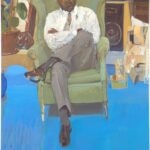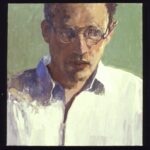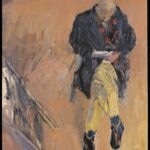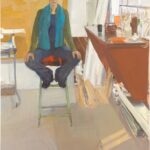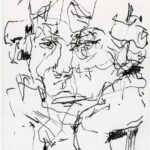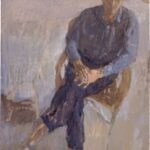Water & Ocean Memory / 2015 – Present
In November 2016 I attended Discovering the Deep Blue Sea, an interdisciplinary conference organized by the National Academies of Science, Medicine and Engineering, and was struck by how little is known of the ocean. Thinking together about this liquid part of our world, beyond our senses, this negative space of knowledge, our workgroup came to ask, “Does the ocean have memories?”
Perhaps because of its openness and poetic resonance, this question inspired us to imagine a framework to explore the ocean across our disciplines using ocean memory as our guide.
Since then I have been co-leading the ocean memory project and slowly developing my own artistic exploration. It is a budding reinvention, a search in painting, sound and video, taking me across land and sea, looking for ways to experience and represent this perceptual shift which I first glimpsed at the conference.
[expand title=”Read More…”]
We obtained two research grants in May 2017 for work which will be conducted by a community of artists, scientists and social scientists.
The first, the Deep Sea Memory Project, involves two interdisciplinary workshops to probe the question and generate new scientific and artistic projects intended to open up the way we understand and communicate about the ocean.
The second, the Ocean Memory Art Project, will fund a collaboration between 3 artists and 3 scientists to create an immersive work of art that explores the deep sea and the polyphonic voices of the ocean’s memory.
Artist at Sea in 2017
Before these grants were awarded, knowing the next phase of my work was going to be aquatic, I applied to several ocean exploration artist residencies. I was chosen by Ocean Exploration Trust (OET) to be the Artist at Sea on their 2017 Nautilus expedition.This fall, I accompanied OET scientists to study submerged prehistoric coastal artifacts off the coast of Oregon and to the Revillagigedo Archipelago to study submarine slope habitats.
Part of this ocean voyage is my own voyage of self-discovery, to confront my ambivalent relationship to water and change in the process, and begin to understand how the ocean’s memory is tied to my own.
[/expand]
Ocean Memory Video WOrks / 2022
In parallel to this exploration of ocean memory, I felt a need to start addressing time in a new way. While painting does encode time in its many layers, this is a kind of simultaneous time to be unwound by the viewer in their viewing of the image, rather than the unfolding time I sought to explore and which is not something I knew how to do. This has led me to an exploration of audio and video as forms of collecting, organizing, and shaping time.
[expand title=”Read More…”]
Why Time?
Because we are the accrual of our memories. Times remembered and times best forgotten. Without them we have no past or future, only the eternal present, without learning, insight or sadness. Some a simple smell, a detail of light, while others are complete stories with start, middle and end; a morality take with which to guide our lives.
But our memories are also what allows us to take a step, and another, and another. They allow the repetitions that makes us perfectly able, to stand up, to walk, to run.
And some go back through the generations and the eons, encoded in our cells, in gene and function, adaptations to change and memories of past states of being.
Our memories are many and multiform, rich and various. Why reduce them to one single thing?
This work is still in its infancy, but here are a couple of examples coming out of a residency at sea with Ocean Exploration Trust, and more recently, a collaboration with Anya Yermakova.
[/expand]
Networks, Maps and Territories / 2014 – 2020
Networks began after my time at the Broad Institute, when I stumbled upon three beautiful thorn trees delineated in snow, and grew from the visual analogy between the tracery of tree branches and other networks in nature (neuronal, cellular, cracks in ice). Always attracted to negative spaces, I was also interested in the formal relationship between these structures and the empty spaces surrounding them.
Though inspired and driven by the sight of trees and brambles, they are fed by the coincidence of rhythms at different scales, which is the root of metaphors.
[expand title=”Read More…”]Networks, Maps and Territories explores the idea that “the map is not the territory.” an idea, first proposed in 1931 by the scientist and philosopher Alfred Korzypski, which posits that a rendering should not be mistaken for the thing itself. However, in paintings—where the painted surface and subject are both on display—the rendering and the thing do often merge. and the territory becomes indistinguishable from the map representing it.
As the paintings searched for their structure, they reached forward to the space of science and back into the space of figuration. Working through the images, I began to feel that here, through the ramifications of the networks, the map and the territory did indeed begin to merge.[/expand]
Genomics – 2003 / 2013
In 2003, Todd Golub, an Oncologist at Dana Farber in Boston wrote to me about some works of mine he had seen. Although my work had never engaged science directly until then, I had been following ideas in physics for many years, in particular the philosophical implications of cosmological models.
Among other things, Todd mentioned his interest in the connection between art and science and this led to a series of visits and a budding collaboration which eventually grew into to my residency at the Broad Institute for genetic research, at MIT and Harvard.
In our early discussions about the nature of Art and Science we found that we shared a common perspective, namely that one can look at science and art as both seeking to put together a vision of the world, each within fairly coherent historical tradition, which in turn allow the vision to be understood.
My fascination with worldviews and paradigm shifts made me want to explore this process first-hand rather than from the ambient culture.
Looking South / 2004
Looking South – based on my 1998 residency in the World Trade Center – is an exploration of the echos between loss, remembrance, tragedy and the perseverance of life as they echoed the city in the years following 911.
Commissioned for Fiduciary Trust Company International’s worldwide headquarters at Rockefeller Center, the painting depicts the view looking south from their offices in Tower Two, and is composed of four 10-foot square oil-on-canvas panels, which rise 41 feet within a four-story interior staircase.
In 2016, the work joined the permanent collection of the 911 Memorial and Museum, where it now hangs.
seen from Above / 2002
In early September of 2001 I was finishing a proposal I wanted to pitch to the Port Authority for a monumental multi-panel piece depicting the view from the towers, but before I was able to present it the events now referred to as 911 took place, and I along with many fellow New Yorkers saw first hand the fall of the towers.
I thought on this day that we had reached the end of art’s capacity to address the real. What could art have left to say in the face of such horror?
As things turned out, there was still a use for art.
To the west, the Hudson’s wide green expanse, layered with receding shapes that fade into a hazy sky. To the east, Brooklyn’s jagged shoreline spilling forward into the East River, topped by a stretch of cloud-mottled cobalt blue. These were typical views before September 11 that all who worked in the Towers experienced as part of their daily routines.[/expand]
Fragile Horizon / 1998 - 2001
In the winter of 1998-99, the Lower Manhattan Cultural Council opened its first World Views residency program. I was one of the 12 lucky artists who got to spend 6 months in these studios in the sky in the unoccupied raw office space on the 91st floor of tower 1. This was a strange and exhilarating time which eventually led to a new body of work based on the view from the towers.
The previous year I had been painting very large still lives in which the back of the table became a virtual horizon. Having wandered to the bar on floor 107 of the World Trade Center I was struck by the view looking east towards Brooklyn and beyond, to Far Rockaway and the sea. There was the horizon! I wondered what would happen if my large but intimate still life horizons met the “actual” horizon, which this view opened up.
I thought it would be great to paint those still lives while looking out at the horizon; to overlay a simple interior view onto the wealth of information available to one looking over the city from this towering point of view. I imagined horizontal images, but of course, nothing is as straightforward as one plans.
[expand title=”Read More…”]As I looked out over the city it became evident I would need to paint it, and the still lives gave way to paintings directly based on the view.
The first paintings of this series which I came to call Fragile Horizon, were started at the very end of the residency and finished the following months at another studio in Brooklyn. A body of etchings and drawings also developed in the course of a printmaking residency later that year where information was channeled back and forth between digital state and zinc plate. These early paintings framed the view over Brooklyn from my 91st floor lair. Their proportions mirrored that of the windows of the tower and they sought to evoke the shifting of water, earth and sky as one moved before the windows of the World Trade Center.
As I worked on them I thought of Japanese and Chinese screens; of the way branches are used to echo and disrupt the vertical format. Out of these concerns, and perhaps a rebellion against the primacy and power of the city, emerged a series of altogether different landscapes.
These works were the beginning of an exploration generated by the World Trade Center and its echo in paint, line, and in my own memory. They explored the encounter between the rhythms of the city and those of other landscapes from which I come. Instead of the temporally specific place of photographs, these paintings and drawings evoked the multiplicity which emerges from the movement between places. They embodied the swing from France (where I grew up) to New York (where I now live) and back in memory and imagination.
Little did I know that two and a half years after my residency these paintings would come carry an altogether different meaning. One where peace and stillness may evoke a terrible sense of loss. The point of view which they embodied was destroyed in a terrible act which shook our society to its core. Like other works investigating the nature of this now disappeared place, they carry some of its existence within them. They are the last images I made before the towers came down taking with them so many lives and the fundamental peace of mind which we had come to expect as our birthright.[/expand]
Interiors / 2002 – 2004
After the World Views residency and making Seen from Above, I looked forward to returning to what I thought of as my own work. I imagined developing the interiors that started with my move to New York; a more abstracted interior space where the perspective might release one’s sense of grounding.
This work pursues the experimentation from Changy to NY with large color fields and the shift of perceived horizontal and vertical axes. The descriptive approach of the earlier paintings is replaced by a sort of metaphysics of place – a focus on color fields, angles and planes, conjuring the suspended presence of the rooms in the house.
The Wheatleigh Hotel / 1997 – 1998
Soon after moving from Paris to New York I met the owners of the Wheatleigh Hotel in Lenox, Mass. They were in the process of a complete renovation of this copy of a florentine palazzo, and were looking for artwork that would echo the european roots and american present of the building. Our early discussions led to a commission for a body of work of both large and intimate pieces which would map the modest home in Changy (see Changy to New York – below) to the wheatleigh itself. As you would navigate the wheatleigh you would encounter paintings which represented what you would see in my own home, virtually mapping the two places onto each other.
The final commission for the Wheatleigh hotel, began in 1997, comprises 15 paintings in both private rooms and public spaces. These images center on a farm house in the center of France which we had owned since I was a child and which had formed the core of my work until then.
[expand title=”Read More…”]Two places are folded into one. The real space of the renovated Wheatleigh hotel and the painted and metaphorical place of the French farmhouse meet. The fabric of building and canvas fold into each other to create multiple layers of experience. The new Wheatleigh’s meeting of classic and contemporary (a modern design within a 19th century copy of a Florentine Palazzo) is echoed within the paintings whose evocation of place embrace both a classical technique and narrative structure, and a strong abstract construction. Each layer feeds the viewers experience to form a totality far exceeding its constituent parts. As you wander about Wheatleigh and discover its works you will build an image with echoes in your own memory. To each viewer a different totality.[/expand]
Changy to NY / 1995 – 2003
This early work centered on a series depicting interiors of my family’s house in the French hamlet of Changy. Although representational in appearance, this work is investigative in nature, imbued with influences from both sides of the Atlantic. From Europe it takes its concern with narrative and time, from America a preoccupation with space.
I have always been concerned with the ways in which Art and Place are linked. The work on the French house dealt not only with its physical appearance but also with the ways in which painting in the West has been tied to the history of Christianity.
As a Jew living in France, these early interiors also represent an attempt to portray the symbology of the Last Supper from a secular perspective.
Of a painting from this series I wrote…
[expand title=”Read More…”]After a trip to Romania I started painting Last Supper images. Quickly this forced me to deal with the complexities of being an assimilated and secular Jew in a catholic country. After exploring this theme head on [in paintings I made for a catholic church], I moved to investigate what the secular expression of this theme could evoke, and started to explore the interior of a house which my family bought in the center of France in 1975, and which has become our family home away from home.
This series centers on the table, at first with figures, and later without. The table represents the center around which the life of the house breathes. Someone will get up early, have coffee at the table and leave. Someone else will come later and be joined by another. Perhaps they have a breakfast conversation. Upon leaving they leave the breakfast fixings on the table for other. In such a way the day winds on, from breakfast to lunch to dinner. The rhythm of the house is written at the table, and these paintings record these events.
As the day passes, the light shifts. Emptiness and silence are followed by the quiet noise of human interaction. A warm ray of sunlight hits the floor below the fireplace. We can hear the silence of our breath.[/expand]
portraits /
Over the years I have regularly come back to portraiture.
This practice – it’s very demand for attention – is a reprieve from the sometimes highly constructed works that account for the bulk of my practice.
The portraits are rooted in the present, in presence, connecting the three players in the room – sitter, painter, and painting. Conversation gently leads to silence, to just being there together. The sitter and painter slowly giving way, the canvas asserting itself.
